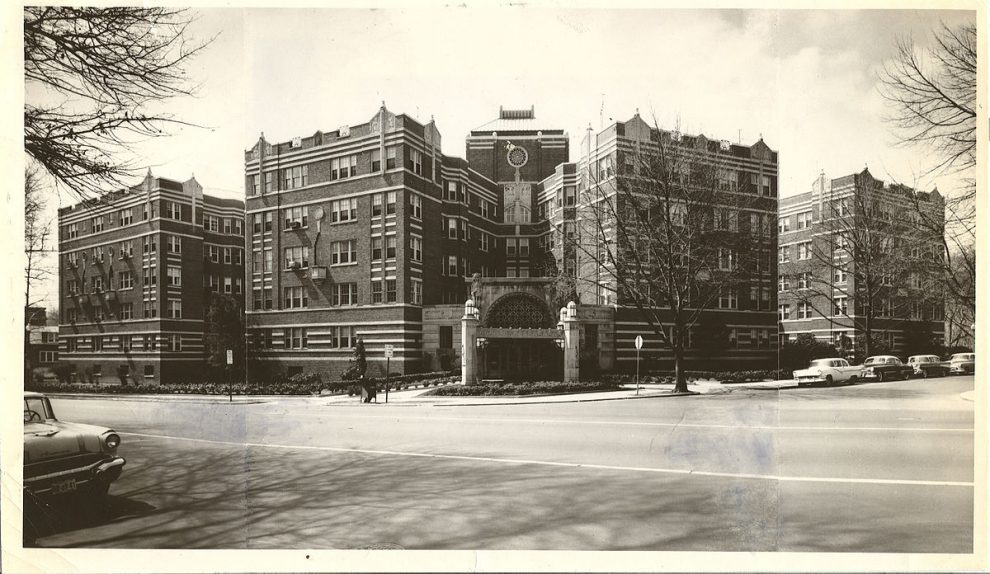The SWAT team, the overdose, the complaints of pot smoke in the air and feces in the stairwell — it would be hard to pinpoint a moment when things took a turn for the worse at Sedgwick Gardens, a stately apartment building in Northwest Washington.
But the Art Deco complex, which overlooks Rock Creek Park and is listed on the National Register of Historic Places, is today the troubled locus of a debate on housing policy in a city struggling with the twin crises of homelessness and gentrification.
Located in affluent Cleveland Park and designed by Mihran Mesrobian — the prewar architect behind such Washington landmarks as the Hay-Adams Hotel — Sedgwick Gardens was once out of reach for low-income District residents.
That changed two years ago, when D.C. housing officials dramatically increased the value of rental subsidies. The goal was to give tenants who had previously clustered in impoverished, high-crime areas east of the Anacostia River a shot at living in more desirable neighborhoods.
At Sedgwick Gardens, the effort met with wild success. As of February, tenants with city-issued housing vouchers had filled nearly half of the building’s roughly 140 units.
Mixed-income developments aren’t rare in the District, where officials often require that new buildings preserve some space for working-class residents.
But the situation at Sedgwick Gardens is different: Many of the new tenants are previously homeless men and women who came directly from shelters or the streets, some still struggling with severe behavioral problems.
The result has been a high-stakes social experiment that so far has left few of its subjects happy. Police visits to the building have nearly quadrupled since 2016. Some tenants have fled. In February, responding to complaints, the city began staffing the building with social workers at night to deal with problems that arise.
Some tenants with vouchers say they have been made to feel unwelcome by their new neighbors, a dynamic that has unavoidable undertones of race and class in a largely white neighborhood.
More established tenants contend that they support the goals of the voucher program, but that it has gone badly awry at Sedgwick Gardens, transforming the building into a dumping ground for people unprepared to live on their own.
Even some Sedgwick Gardens residents who receive public assistance say the complex was colonized by the city’s housing programs too rapidly and without sufficient oversight.
“It’s not about the voucher program. It’s not about racism. It’s about people’s conduct and behavior,” said Lorraine Starkes, 61, a formerly homeless woman who moved into Sedgwick Gardens using a voucher about two years ago.
Starkes, who is black, said some of her fellow tenants with vouchers were not properly screened by city officials before moving in. Now, she said, those residents have overwhelmed her new home and “are trying to turn it into a ghetto.”
The drama within Sedgwick Gardens’s red-brick walls exposes challenges and contradictions in the “housing first” policies for reducing homelessness that have been adopted by the District and many other cities.
That approach calls for placing the homeless in long-term housing without first requiring treatment for mental illness or addiction. Many experts say it is the best way to help people who have trouble helping themselves amid the chaos of homelessness.
But as housing first has emerged as a national policy consensus, some have begun to warn that it is being applied too broadly and at times with inadequate support for people who aren’t ready for the independence and responsibilities of living by themselves.
City officials insist those mistakes have not been made at Sedgwick Gardens, calling the disturbing incidents isolated cases.
“I think the reason the issues at Sedgwick Gardens came to a head is that there were a couple of residents that were causing a problem. That could have been true whether they had a voucher or not,” said D.C. Council member Brianne K. Nadeau (D-Ward 1), who chairs the council’s Committee on Human Services. “I want us to be careful not to demonize everyone who finds stable housing through a subsidy because not everybody who needs a subsidy is a criminal.”
Built in 1931, Sedgwick Gardens rises on Connecticut Avenue NW less than a mile north of the National Zoo. Past an elegant stone carriage porch is a cavernous lobby, ringed by Moorish arches and featuring a fountain of marble and blue tile, that could be the setting for a scene in a Raymond Chandler novel.
Until recently, the building was occupied by a quiet mix of tenants made up primarily of couples and single apartment dwellers, said Carren Kaston, a former literature professor who has lived at the complex for more than three decades and is president of the Sedgwick Gardens Tenant Association.
That began to change about two years ago.
In late 2016, the board of the D.C. Housing Authority — which sets payment standards for vouchers issued in the city — increased the maximum value of vouchers to 175 percent of fair market rent, as set by the U.S. Department of Housing and Urban Development.
That meant vouchers could be used for one-bedroom apartments renting at up to $2,648 a month, according to Housing Authority documents. At Sedgwick Gardens, the going rate for one-bedroom units was about $2,200 per month in 2017, according to a former tenant who moved in that year without public assistance.
Tenants with vouchers pay 30 percent of whatever income they have toward rent, with the city subsidizing the rest.
The move came in a city desperate to offer its residents more affordable living options — and to move the chronically homeless off the street. At the last official count in 2018, there were 6,904 homeless people in the District, which has a population of just over 700,000. A recent study by the National Community Reinvestment Coalition found that the District has experienced the most intense gentrification of any city in the country.
Naimah Simkins, the former property manager at Sedgwick Gardens, said that in early 2017, she listed basement units she was having trouble leasing on a U.S. Department of Veterans Affairs website. Soon, there was a trickle of formerly homeless or low-income veterans bearing vouchers issued by the D.C. government.
Cleveland Park is a bastion of urbane liberalism where just 1 in 20 voters supported President Trump in the 2016 election. Yet from the beginning, Simkins said, it was clear that some of the building’s older residents were discomfited by the new basement dwellers.
She likened the dynamic to “The People Under the Stairs,” a 1991 kitsch horror movie in which a well-to-do couple live above a cellar filled with mistreated children.
“It would be, like, the smallest thing that they would call the police on,” Simkins said. She said the more established tenants “feel uneasy, but if they would just reach out and talk, they would see that (tenants with vouchers) are human beings, too.”
After moving into the building about two years ago, voucher holder Joseph A. Bundy, 69, said he was smoking outside one day when another resident approached him: “This lady came up and said, ‘Don’t you know there’s a park up the street?’ I said, ‘What you talking about, a park up the street? My home’s right here.’ ”
Lawrence Hilliard, a 69-year-old Marine Corps veteran who previously lived at the homeless men’s shelter on New York Avenue, said a social worker took him on a tour of apartments where he could use his rental voucher. At the initial addresses in Southeast, Hilliard said he was warned by residents that the sound of gunshots made it hard to sleep at night.
Sedgwick Gardens, in a neighborhood of parks and small businesses where Hilliard had done odd jobs as a young man, was a revelation.
“It was away from the violence and the foolishness, man, that’s the main thing,” he said, smoking a cigarette on a recent evening in the building’s parking lot, which adjoins a vibrant patch of World War II victory gardens still tended by community members. “And then the violence and the foolishness came up here.”
CBP officer fires weapon during road rage incident near JFK Airport entrance
Trump admin fights in court to keep White House East Wing demolition, $300M ballroom build on track
Democrats push DOJ to reveal hidden half of Jack Smith report as GOP prepares tense deposition
MIT professor shot dead in Brookline home, Massachusetts State Police launch homicide investigation
The White House Reportedly Chastised Netanyahu with a ‘Stern’ Message After Weekend Strike
SNAP Recipient Complains About New Rules Blocking Junk Food Purchases: ‘What Is the Point?’
FBI doubted probable cause for Mar-a-Lago raid but pushed forward amid pressure from Biden DOJ, emails reveal
Ex-NFL reporter Michele Tafoya close to deciding on Minnesota Senate bid
Kennedy urges GOP to restart spending battle amid soaring cost of living, warns against wasting majority
Watch: Providence Police Chief Gives Astonishingly Unacceptable Response When Asked What Shooter Shouted Before Gunning Down Students
Late Breaking Video: Trump Takes Out Big Batch of Narco Terrorists in Highly Effective 3-Boat Strike
Rob Reiner’s son Nick’s struggles come into focus after parents’ deaths and more top headlines
House GOP tensions erupt as Republicans turn on each other heading into year’s end
Brian Glenn reveals engagement to Rep Marjorie Taylor Greene: ‘She said ‘yes”
‘Ghost ships’ ferrying illicit oil have sailed into Trump’s crosshairs
There were 121 calls for police service at Sedgwick Gardens in 2018, up from 34 in 2016. City officials said despite that volume, officers determined just five times last year that a crime had taken place. Still, a number of the incidents left residents rattled.
On Palm Sunday of last year, officers responding to a noise complaint encountered Robert Gingell, who according to a police report could be heard throwing objects around his third-floor apartment.
When they knocked on the door, Gingell allegedly said, “If you try to come into my apartment, I have a shotgun and will shoot all of you. I will pick you off one by one.”
A police tactical team filed through the historic carriage porch and across the limestone-and-marble lobby and set up a perimeter outside Gingell’s apartment, where he holed up until the next morning. Although no gun was found, Gingell was arrested. He was released — and then arrested again at Sedgwick Gardens two days later, accused of striking another tenant in the head with a flashlight.
Gingell could not be reached for comment. Court documents say he pleaded guilty to a charge of attempted threats to do bodily harm, agreeing to undergo mental health and substance abuse assessments and treatment as necessary.
In February, his community supervision officer reported that he no longer lived at Sedgwick Gardens, but at another apartment building in Northwest Washington.
About a month after the SWAT team’s visit, police were called to the building to investigate the whereabouts of 68-year-old tenant Jacob Brooks, who according to building staff had not been seen in weeks. When he did not answer his door, police entered his apartment and found him on the floor of his bedroom, unconscious and not breathing, according to an incident report. Fire and emergency medical services officials called to the scene declared him dead.
The chief medical examiner determined that his death was caused by drugs including fentanyl, a synthetic opioid that often causes overdoses when it is mixed with heroin.
City officials declined to say whether Gingell or Brooks were receiving rental assistance, citing privacy laws.
Tenants say they have also confronted a slew of less serious nuisances such as panhandling, marijuana smoke in the halls and feces discovered on a landing in the stairwell.
Story cited here.
























